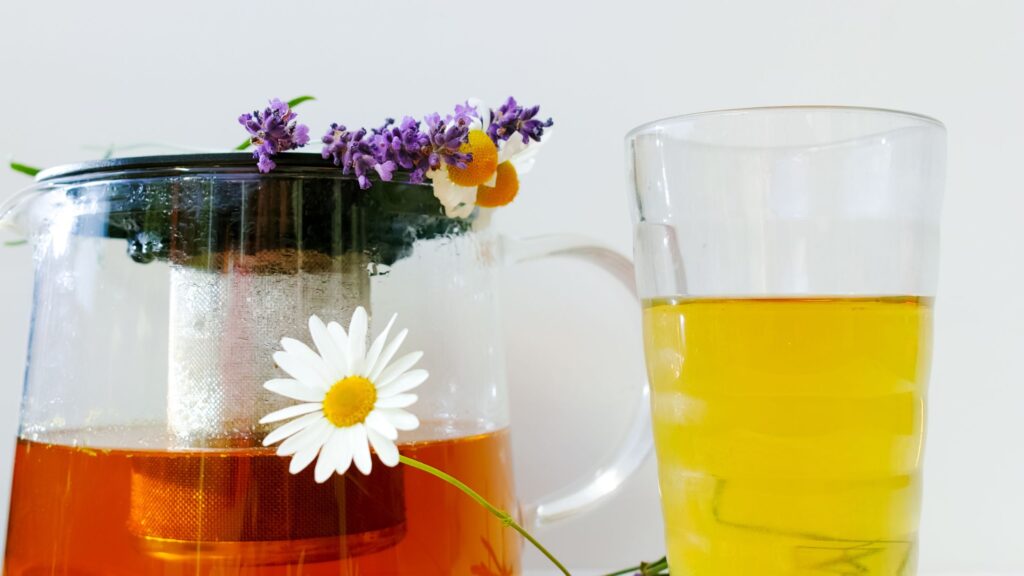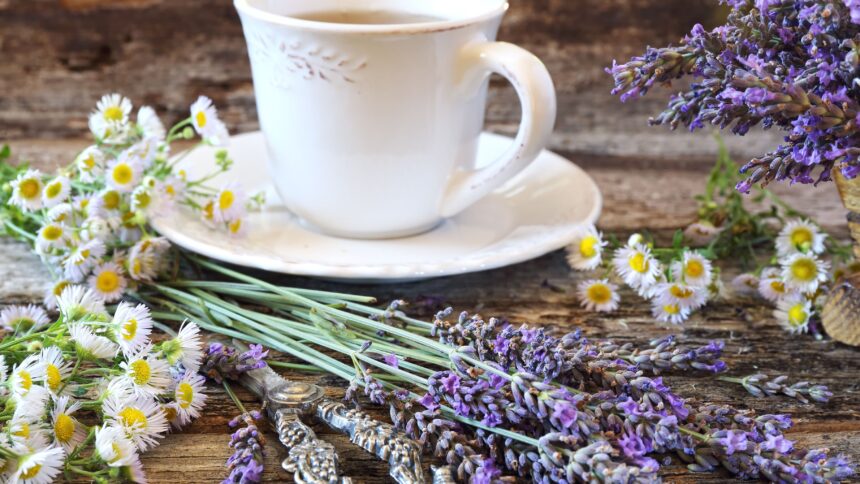Lavender chamomile tea is not just a delightful beverage; it’s a blend that offers a wealth of naturally soothing benefits. Combining the calming properties of lavender with the gentle relaxation of chamomile, this tea has been cherished for centuries across various cultures. In this article, we will explore the myriad ways lavender chamomile tea can enhance your well-being, providing both physical and mental health benefits.
The Origin and History of Lavender Chamomile Tea
Lavender and chamomile have long histories as medicinal herbs. Lavender, with its alluring fragrance and beautiful purple blooms, has been used in aromatherapy and traditional medicine since ancient times. The Romans and Egyptians used lavender in their bathing rituals and for its healing properties. Chamomile, on the other hand, has been a staple in herbal medicine, dating back to ancient Egypt, Greece, and Rome. The dried flowers of chamomile are known for their calming effects and are commonly used to treat insomnia, anxiety, and digestive issues.
The combination of lavender and chamomile into a single tea harnesses the benefits of both herbs, creating a soothing beverage that promotes relaxation and well-being. This blend has gained popularity in modern times as people seek natural remedies for stress and sleep disorders.
The Health Benefits of Lavender Chamomile Tea
Promotes Relaxation and Reduces Anxiety
One of the most well-known benefits of lavender chamomile tea is its ability to promote relaxation and reduce anxiety. Lavender is renowned for its calming effects on the nervous system. It can help reduce stress, ease tension, and alleviate symptoms of anxiety. Chamomile, similarly, is often used for its sedative properties. When combined, these herbs create a powerful blend that can help calm the mind and body, making it an excellent choice for those looking to unwind after a hectic day.
Improves Sleep Quality
For those struggling with insomnia or poor sleep quality, lavender chamomile tea can be a game-changer. Chamomile is a natural mild tranquilizer and sleep inducer, often referred to as a “sleep herb.” Lavender, too, is known for its ability to enhance sleep. Drinking a cup of lavender chamomile tea before bed can help you fall asleep faster and enjoy a deeper, more restful sleep. The tea’s natural compounds interact with receptors in the brain, promoting a sense of calm and helping regulate sleep patterns.
Aids Digestion
Lavender chamomile tea is also beneficial for the digestive system. Chamomile has been used traditionally to treat various gastrointestinal issues, including indigestion, bloating, and gas. It can help relax the muscles in the digestive tract, facilitating smoother digestion. Lavender, with its anti-inflammatory properties, can further soothe the digestive system. Drinking this tea after meals can help alleviate discomfort and promote better digestion.
Supports Immune Health
Both lavender and chamomile are rich in antioxidants, which are essential for maintaining a healthy immune system. Antioxidants help combat free radicals in the body, reducing oxidative stress and inflammation. Regular consumption of lavender chamomile tea can boost your immune system, helping your body fend off common illnesses and infections.
Relieves Headaches and Migraines
The combination of lavender and chamomile can also be effective in relieving headaches and migraines. Lavender is known for its ability to reduce pain and inflammation, while chamomile’s calming effects can help alleviate tension headaches. Sipping on a cup of this tea can provide natural relief from headaches, offering a gentle alternative to over-the-counter medications.
How to Prepare Lavender Chamomile Tea

Preparing lavender chamomile tea is simple and can be done with either fresh or dried herbs. Here’s a basic recipe:
Ingredients
- 1 teaspoon of dried chamomile flowers (or 1 chamomile tea bag)
- 1 teaspoon of dried lavender buds
- 2 cups of boiling water
- Honey or lemon (optional, for taste)
Instructions
- Boil Water: Bring 2 cups of water to a boil.
- Combine Herbs: Place the dried chamomile flowers and lavender buds in a teapot or infuser.
- Steep: Pour the boiling water over the herbs and let them steep for about 5-10 minutes. The longer you steep, the stronger the flavor.
- Strain: If using loose herbs, strain the tea into a cup. If using tea bags, simply remove them.
- Serve: Add honey or lemon to taste if desired. Enjoy your soothing cup of lavender chamomile tea!
Incorporating Lavender Chamomile Tea into Your Routine
Adding lavender chamomile tea to your daily routine can be a simple yet effective way to enhance your overall well-being. Here are a few tips on how to incorporate this soothing beverage into your life:
Morning Ritual
While lavender chamomile tea is often associated with bedtime, it can also be a wonderful way to start your day. Drinking a cup in the morning can set a calming tone for the day ahead, helping you approach your tasks with a sense of peace and clarity. If you find that your mornings are particularly stressful, a calming cup of lavender chamomile tea can help you start on the right foot.
Midday Break
Incorporating a tea break into your midday routine can provide a much-needed pause to recharge and refocus. The naturally soothing benefits of lavender chamomile tea can help alleviate any stress or tension that has built up during the morning, allowing you to return to your tasks with renewed energy and a calm mind.
Evening Relaxation
The most popular time to enjoy lavender chamomile tea is in the evening. After a long and possibly stressful day, a warm cup of this tea can help you unwind, relax, and prepare for a restful night’s sleep. Make it a part of your nighttime ritual – perhaps with a good book or a warm bath – to maximize its calming effects.
Anytime Stress Relief
Keep lavender chamomile tea on hand for those moments when you need immediate stress relief. Whether you’re dealing with a sudden bout of anxiety, a headache, or just need a moment of calm, this tea can provide quick and natural relief.
Potential Side Effects and Considerations
While lavender chamomile tea is generally safe for most people, it’s important to be aware of potential side effects and considerations:
Allergies
Some individuals may have allergies to chamomile or lavender, particularly those who are allergic to plants in the Asteraceae family (such as ragweed, marigolds, and daisies). If you have known allergies to these plants, it’s best to avoid lavender chamomile tea or consult with a healthcare professional before trying it.
Pregnancy and Breastfeeding
Pregnant or breastfeeding women should exercise caution when consuming herbal teas. While chamomile is often considered safe in moderation, it’s advisable to consult with a healthcare provider to ensure it’s appropriate for your specific situation.
Interactions with Medications
Chamomile and lavender can interact with certain medications, including blood thinners, sedatives, and medications for blood pressure. If you are taking any prescription medications, it’s important to consult with your healthcare provider before incorporating lavender chamomile tea into your routine.
The Science Behind the Benefits
Understanding the science behind the benefits of lavender chamomile tea can further enhance its appeal. Both herbs contain compounds that contribute to their therapeutic properties:
Lavender
Lavender contains linalool and linalyl acetate, compounds known for their calming effects. Research has shown that inhaling lavender essential oil or consuming lavender can reduce anxiety levels, promote relaxation, and improve sleep quality. These compounds interact with the neurotransmitters in the brain, helping to modulate mood and induce a sense of calm.
Chamomile
Chamomile is rich in antioxidants like apigenin, which binds to specific receptors in the brain that help reduce anxiety and initiate sleep. Studies have demonstrated chamomile’s effectiveness in improving sleep quality and duration, as well as its potential to reduce symptoms of generalized anxiety disorder.
Exploring Variations and Additions
While lavender chamomile tea is delightful on its own, you can experiment with various additions and variations to suit your taste preferences and enhance its benefits:
Adding Honey or Lemon
A spoonful of honey can add natural sweetness and an extra layer of soothing properties to your tea. Lemon, on the other hand, can provide a refreshing twist and additional vitamin C.
Blending with Other Herbs
Consider blending lavender chamomile tea with other calming herbs like peppermint, lemon balm, or valerian root. Each of these herbs provides unique benefits that can complement and enhance the effects of lavender and chamomile.
Iced Lavender Chamomile Tea
For a refreshing variation, try making iced lavender chamomile tea. Simply brew the tea as usual, let it cool, and pour it over ice. You can add a slice of lemon or a sprig of fresh mint for an extra refreshing touch.
Conclusion
Lavender chamomile tea is a timeless blend that offers a host of naturally soothing benefits. From promoting relaxation and reducing anxiety to improving sleep quality and aiding digestion, this tea is a versatile and healthful addition to your daily routine. Whether you enjoy it hot or iced, in the morning or evening, incorporating lavender chamomile tea into your life can help you cultivate a sense of calm and well-being.
Embrace the natural power of lavender chamomile tea and experience the tranquility it can bring to your mind and body. As with any herbal remedy, it’s important to listen to your body and consult with a healthcare professional if you have any concerns. Enjoy the journey to a more relaxed and balanced lifestyle, one soothing sip at a time.




